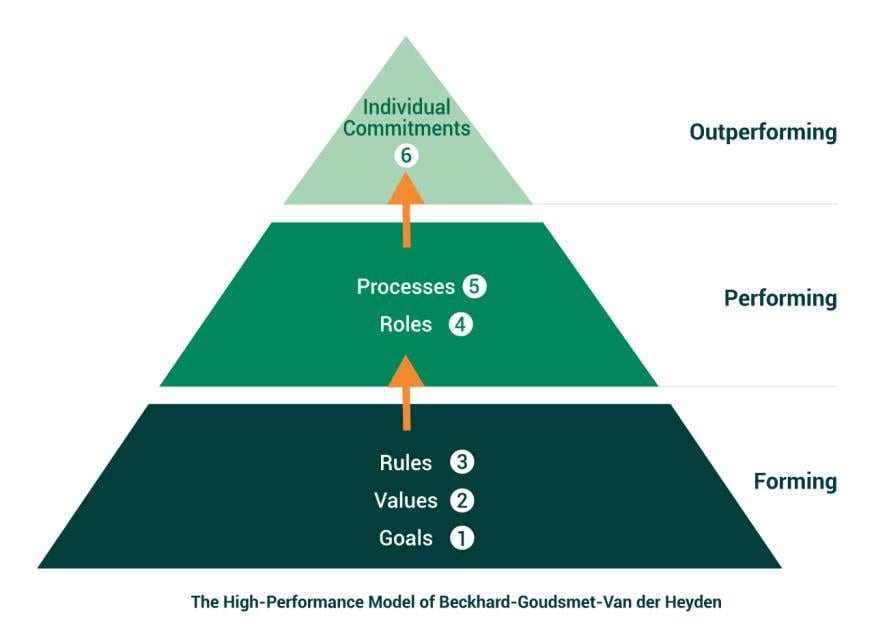
In 1996, expert climber David Breashears* united his team behind a seemingly impossible goal: capture Mount Everest on IMAX film.
While many climbers pursue the peak with a singular obsession, Breashears never forced his team to get to the top, as he believed the mountain “has to allow us to climb it”. This wisdom led them to turn back on their first ascent when they felt conditions were not secure.
It was on their second attempt that Breashears’ team not only achieved their filmmaking goal, but also assisted climbers caught in a sudden, devastating blizzard. This dramatic rescue became the focus of their documentary Everest, the highest-grossing IMAX film ever made.
This historic expedition is a powerful case study, demonstrating the six key dimensions needed to manage a team for high performance: goals, values, rules, roles, processes and individual commitment.
Drawing on insights from our studies in sports and corporations, we propose an expansion of the famous GRPI framework (goals, roles and responsibilities, process and interpersonal relations) developed by Richard Beckhard in 1972. In our recent working paper, we argue that the framework omits two essential elements: values and rules. These additional dimensions are essential for building teams that go beyond simply functioning and truly excel.
We therefore propose an extended model which neatly breaks these six dimensions down into three levels (see figure 1). At the base, goals, values and rules are common to all team members, and provide team solidarity amongst members. The second level encompasses roles and processes which are specific to certain individuals or subgroups. Finally, at the apex, individual commitment is unique to each team member. It’s essential to address these elements in sequential order to achieve full alignment.

Goals, values and rules: securing the team’s mission
Goals, values and rules are three distinct and complementary ways to bond team members. Together, these elements create the solidarity needed for group members to become a true team.
Goals are the foundational element of teams. They provide a shared purpose and direction for the team's efforts. Once goals are established, values and rules then come into play and define how those goals will be achieved.
Values are the team's guiding principles for interacting with one another and external stakeholders. These principles define the expected behaviours within the team, such as integrity, collaboration and trust.
Rules translate values into action. Unlike aspirational values, they are specific and require compliance. They set clear boundaries for team behaviour and ensure actions align with both the team's goals and its core values.
The IMAX team's goal was a complex filming project, more about exploring the majestic mountain than just executing the climb. Focusing on this goal was a key factor in avoiding the tragedies that befell other teams aiming to reach the top at any cost.
Breashears insisted on carefully selecting team members based on their values. He looked for individuals who were selfless, respectful of the mountain and their teammates, and embodied the courage and autonomy of skilled mountaineers. This meant they could solve problems they faced without creating issues for others.
This emphasis on the right values directly shaped the rules enforced by team members. Strict rules such as “going up is optional, coming down is mandatory" and "we have options and slack" were like a mantra to Breashears.
This optionality extended to leadership roles. Breashears recognised the danger of a single leader on a mountain where anyone could become incapacitated. To address this, he introduced a shared leadership model with his two assistant guides, ensuring he wouldn't be the sole decision-maker. These simple practices and clear rules were noticeably absent or disregarded by the teams that met with disaster.
In the business world, these three elements of goals, values and rules can be thought of as the foundational trinity that defines a business project or a company's mission. Unfortunately, these crucial elements are often overlooked or rushed during team formation. Such a hasty approach can lead to many dysfunctions and problems within the team down the line.
Roles, processes and individual commitments: the performance ingredients
Once the team's mission has been clearly specified, the next step is to specify how it will be achieved. This is where delegation (roles), mutual adjustments (processes) and individual commitments come into play.
Roles define the tasks to be accomplished and the specific responsibilities of each team member. Clear roles help engagement, prevent confusion, and promote team cohesion and commitment.
Processes guide the interactions among key members. These include how to communicate, generate and explore options, make decisions, agree on strategies and tactics, identify and anticipate new challenges, and resolve potential conflicts with each other and stakeholders. Well-defined processes ensure smooth collaboration, efficient problem-solving and team collaboration.
Ultimately, the success of the team depends heavily on the efforts and contributions of each member. Attention therefore needs to be paid to individual needs and motivations to ensure each member feels fully invested in the team's mission and success. Individual commitment – the most important ingredient – is thus both the final element needed to build and manage effective teams.
Breashears' Everest team exemplified all these elements in action. Even novice climbers played a vital role as risk managers by asking seemingly simple yet potentially life-saving questions like "Is this really okay?" These questions, easily overlooked by seasoned leaders due to overconfidence, make all the difference. Sherpas, with their deep and intuitive knowledge of Everest, played the vital role of mountain experts, heavily influencing the crucial decision to turn back on the first attempt.
Another critical ingredient to the team’s sustained performance lay in their processes – refined over years of experience and explicitly shared with all team members. Pre-established scenarios, based on past climbs, were sent to all members to study and challenge. Team members were asked to come up with improvements or scenarios that may be missing. If they could not, these scenarios became the team's “law of the land”. These pre-agreed scenarios reduced uncertainty and were a way to manage the risks that arise in Everest’s “death zone”.
Individual commitments thrived because of these practices. As team members actively participated and contributed, their trust and confidence grew – in the project itself, its goals, the leadership, their team members and ultimately, the processes that guided them.
We shared our GVRu/RoP/I model with Breashears, who immediately validated its usefulness as a checklist. He confirmed that each time he or other teams ran into trouble, it was indeed due to a failure in one or several of the six dimensions in the model.
In a corporate context, this model acts as a valuable checklist for managers, whether preparing for a project or a simple meeting. One project manager, after learning about the model, realised he'd made a critical mistake. Too eager to impress his CEO, he had hastily accepted a project leadership role without fully understanding the project's goals (set too high) and the rules guiding requests for additional resources. His quick acceptance set him up for failure, as he hadn't discussed the goals or whether he could request for more resources to achieve them.
By proactively addressing each dimension sequentially, leaders can create high-performing teams capable of achieving remarkable things, just like Breashears's team on Everest. This approach can help teams avoid the pitfalls of unclear goals, misaligned values or poorly defined roles and processes. It ensures everyone is working together towards the same vision, delivering the expected results, and prepared to adapt to any challenge that may arise.
*In memory of our dear friend David Breashears, who passed away at his home on March 14, 2024. May his final ascent be a blessed one.
Edited by:
Katy ScottAbout the research
-
View Comments
(2) -
Ankit VIJAYAVARGIYA
The principles in this article resonate deeply with my experience in managing projects. For our current SAP implementation project, I've realized we lack pre-agreed scenarios, a key element emphasized here, which could have addressed issues from previous failures. This insight has reinforced the importance of anticipating challenges and planning effectively as part of our Processes. I’m eager to incorporate these strategies into my future projects to drive success. Thank you for sharing these valuable insights!
-
Leave a Comment





Emmanuel AUBLET
04/06/2024, 09.39 pm
Thank you for this interesting paper.
I would argue that creating an environment of psychological safety, where one feels at ease to display a worry or unease with a potential direction would be the base of the pyramid: the "Is this really okay?" question must be ask without fear of scorn, nor evaluation by any member of the team, be them the most junior.